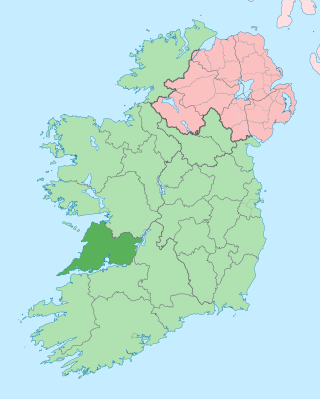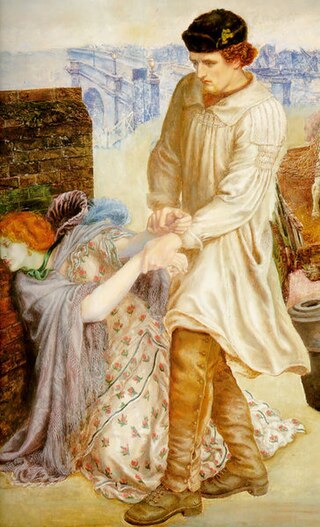
Blackwork, sometimes historically termed Spanish blackwork, is a form of embroidery generally worked in black thread, although other colours are also used on occasion, as in scarletwork, where the embroidery is worked in red thread. Most strongly associated with Tudor period England, blackwork typically, though not always, takes the form of a counted-thread embroidery, where the warp and weft yarns of a fabric are counted for the length of each stitch, producing uniform-length stitches and a precise pattern on an even-weave fabric. Blackwork may also take the form of free-stitch embroidery, where the yarns of a fabric are not counted while sewing.

County Clare is a county in the province of Munster in the Southern part of the republic of Ireland, bordered on the west by the Atlantic Ocean. Clare County Council is the local authority. The county had a population of 127,938 at the 2022 census. The county seat and largest settlement is Ennis.

Bunratty Castle is a large 15th-century tower house in County Clare, Ireland. It is located in the centre of Bunratty village, by the N18 road between Limerick and Ennis, near Shannon Town and its airport. The castle and the adjoining folk park are run by Shannon Heritage as tourist attractions.

Killone Abbey, situated in Killone, some 5 kilometres south of Ennis, County Clare, was a nunnery and abbey of Canonesses Regular founded in 1190 by Donal Mor O'Brien, King of Thomond and Munster and dedicated to Saint John. It lies on the banks of Killone Lake.
Liscannor is a coastal village in County Clare, Ireland. It is located on the R478 road between Lahinch and Doolin, close to the Cliffs of Moher. As of the 2016 census it had a population of 113.

Limerick lace is a specific class of lace originating in Limerick, Ireland, which was later produced throughout the country. It evolved from the invention of a machine which made net in 1808. Until John Heathcoat invented a net-making machine in Devon in 1815, handmade net was a very expensive fabric. This meant cheap net became available to Irish lacemakers, particularly after 1823 when Heathcoat's patent expired.

A smock-frock or smock is an outer garment traditionally worn by rural workers, especially shepherds and waggoners. Today, the word smock refers to a loose overgarment worn to protect one's clothing, for instance by a painter.

The Honan Chapel is a small Catholic church built in the Hiberno-Romanesque revival style on the grounds of University College Cork, Ireland. Designed in 1914, the building was completed in 1916 and furnished by 1917. Its architecture and fittings are representative of the Celtic Revival movement and evoke the Insular art style prevalent in Ireland and Britain between the 7th and 12th centuries.

Ukrainian embroidery occupies an important place among the various branches of Ukrainian decorative arts. Embroidery has a rich history in Ukraine, and has long appeared in Ukrainian folk dress as well as played a part in traditional Ukrainian weddings and other celebrations. Appearing all across the country, Ukrainian embroidery varies depending on the region of origin. From Poltava, Kyiv, and Chernihiv in the east, to Volyn and Polissia in the northwest, to Bukovina, and the Hutsul area in the southwest, the designs have a long history which defines its ornamental motifs and compositions, as well as its favorite choice of colors and types of stitches.

Doonbeg is a village in west County Clare, Ireland on the Atlantic coast. The surrounding natural environment has supported its development as a tourist resort. The area was officially classified as part of the West Clare Gaeltacht, an Irish-speaking community, until 1956.

English embroidery includes embroidery worked in England or by English people abroad from Anglo-Saxon times to the present day. The oldest surviving English embroideries include items from the early 10th century preserved in Durham Cathedral and the 11th century Bayeux Tapestry, if it was worked in England. The professional workshops of Medieval England created rich embroidery in metal thread and silk for ecclesiastical and secular uses. This style was called Opus Anglicanum or "English work", and was famous throughout Europe.

Wilhelmina GeddesHRUA was an Irish stained glass artist who was an important figure within the Irish Arts and Crafts movement and also the twentieth century British stained glass revival. Notable works include windows at St Bartholomew's, St Peter's Church, and the King Albert Memorial Window, St Martin's Cathedral.

Killone is a civil parish of County Clare, Ireland, to the southwest of Ennis. It is known for the ruins of Killone Abbey on the grounds of Newhall House and Estate.
Florence Vere O'Brien was a British diarist, philanthropist, and craftswoman. She set up The Limerick Lace School and Clare Embroidery.
Ethel Rhind was an Irish stained-glass and mosaic artist, who was associated with An Túr Gloine.
Catherine Amelia "Kitty" O'Brien was an Irish stained glass artist, and a member and director of An Túr Gloine.

Embroidery was an important art in the Islamic world from the beginning of Islam until the Industrial Revolution disrupted traditional ways of life.
Bed hangings or bed curtains are fabric panels that surround a bed; they were used from medieval times through to the 19th century. Bed hangings provided privacy when the master or great bed was in a public room, such as the parlor. They also kept warmth in, and were a way of showing one's wealth. When bedrooms became more common in the mid-1700s, the use of bed hangings diminished.

Newhall House is a 17th century country house and estate, heavily modified and rebuilt during the Georgian period to its current appearance near Ennis in County Clare.















